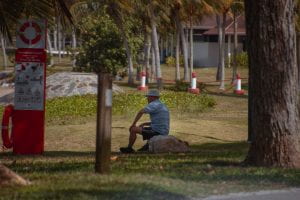(these pictures were taken with the consent of the man in the image, although he did not want to disclose his name)
Whilst walking through Pasir Ris Park, I noticed a lot of the older generation of Singapore sitting alone looking out into the sea. A common stereotype associated with the older generation is more insensitive, tough, thinking the younger/modern generation have it all easy, and either disappointed or grateful for their life.
In these two images, I have the same elderly man alone just sitting down enjoying the view of the sea. I decided to isolate my subject by making sure he was the only person in the frame, trying to use a lower aperture so there would be a little more background/foreground blur creating a shallower depth of field (which I was not able to accomplish due to wrong camera settings), and using the rule of thirds to frame him in the bottom left-hand corner to show that there is a lot more of the world around him.
I wanted to tell the story of a man who was contemplating his decisions throughout life, with all of us living in regret, just looking back and thinking about our past decisions really make us reflect on the mistakes we have made. A lot of the older generation say that they are satisfied with what they have done in their lives but is that really true? Everyone feels alone in this world, loneliness is one of the leading causes of depression, it is a common human instinct to want to feel appreciated and loved by another human being. This man might have lost a loved one, thinking about his future, his past, maybe suffering from a mental disorder, I will never know. Mental health among the older generation is something a lot of our modern generation do not consider as it is common amongst the younger generations.
We all have something we go through. My generation (Generation Z) and Millenials are not the generations going through something.
“Everybody’s got something” – Sneako

